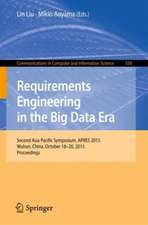Software Visualization: Visualizing the Structure, Behaviour, and Evolution of Software
Autor Stephan Diehlen Limba Engleză Hardback – 24 apr 2007
So far, there exist only anthologies and proceedings about software visualization. With this book, Stephan Diehl has written the first textbook on software visualization. As such it targets both students and teachers in computer science. Topics covered include static program visualization, algorithm animation, visual debugging, as well as the visualization of the evolution of software. The author's presentation emphasizes common principles and provides different examples mostly taken from seminal work. In addition, each chapter is followed by a list of exercises including both pen and paper exercises, as well as programming tasks. Although written mostly for graduate students, the book will also be a source for researchers in both academia and industry, as it will provide a broad and systematic overview of the area including many pointers to tools available today.
| Toate formatele și edițiile | Preț | Express |
|---|---|---|
| Paperback (2) | 327.62 lei 6-8 săpt. | |
| Springer Berlin, Heidelberg – 14 oct 2010 | 327.62 lei 6-8 săpt. | |
| Springer Berlin, Heidelberg – 10 apr 2002 | 338.49 lei 6-8 săpt. | |
| Hardback (1) | 333.22 lei 6-8 săpt. | |
| Springer Berlin, Heidelberg – 24 apr 2007 | 333.22 lei 6-8 săpt. |
Preț: 333.22 lei
Preț vechi: 416.52 lei
-20% Nou
Puncte Express: 500
Preț estimativ în valută:
63.76€ • 66.75$ • 52.76£
63.76€ • 66.75$ • 52.76£
Carte tipărită la comandă
Livrare economică 05-19 aprilie
Preluare comenzi: 021 569.72.76
Specificații
ISBN-13: 9783540465041
ISBN-10: 3540465049
Pagini: 187
Ilustrații: XII, 187 p. 124 illus., 75 illus. in color.
Dimensiuni: 155 x 235 x 17 mm
Greutate: 0.44 kg
Ediția:2007
Editura: Springer Berlin, Heidelberg
Colecția Springer
Locul publicării:Berlin, Heidelberg, Germany
ISBN-10: 3540465049
Pagini: 187
Ilustrații: XII, 187 p. 124 illus., 75 illus. in color.
Dimensiuni: 155 x 235 x 17 mm
Greutate: 0.44 kg
Ediția:2007
Editura: Springer Berlin, Heidelberg
Colecția Springer
Locul publicării:Berlin, Heidelberg, Germany
Public țintă
Professional/practitionerCuprins
Visualization Basics.- Static Program Visualization.- Dynamic Program Visualization.- Visualizing the Evolution of Software Systems.- Evaluation.- Conclusions.
Recenzii
From the reviews:
"As the first existing textbook on software visualization, Diehl has managed to put together a good overview of this interesting field."
"Diehl steers the reader through different techniques as a good tourist guide would do: pointing out the most significant aspects, while leaving out many details that might be of partial interest for his intended audience." (Fernando Berzal, Computing Reviews, December 2007)
"...this is a book with clear explanations that is well structured and easy to read, yet profound enough for a second, more thorough reading." (Jose Lloret, Computing Reviews, October 2007)
"As the first existing textbook on software visualization, Diehl has managed to put together a good overview of this interesting field."
"Diehl steers the reader through different techniques as a good tourist guide would do: pointing out the most significant aspects, while leaving out many details that might be of partial interest for his intended audience." (Fernando Berzal, Computing Reviews, December 2007)
"...this is a book with clear explanations that is well structured and easy to read, yet profound enough for a second, more thorough reading." (Jose Lloret, Computing Reviews, October 2007)
Notă biografică
Stephan Diehl is a full professor for computer science at the University of Trier, Germany. His research interests include programming languages and compiler design, web technologies, educational software and visualization, in particular software visualization. He teaches courses on software visualization at university as well as in industry and has been heavily involved in various international software visualization related events.
Textul de pe ultima copertă
Software visualization encompasses the development and evaluation of methods for graphically representing different aspects of software, including its structure, its execution, and its evolution. Software visualization combines techniques from areas like software engineering, programming languages, data mining, computer graphics, information visualization and human-computer interaction.
So far, there exist only anthologies and proceedings about software visualization. With this book, Stephan Diehl has written the first textbook on software visualization. As such it targets both students and teachers in computer science. Topics covered include static program visualization, algorithm animation, visual debugging, as well as the visualization of the evolution of software. The author's presentation emphasizes common principles and provides different examples mostly taken from seminal work. In addition, each chapter is followed by a list of exercises including both pen and paper exercises, as well as programming tasks. Although written mostly for graduate students, the book will also be a source for researchers in both academia and industry, as it will provide a broad and systematic overview of the area including many pointers to tools available today.
So far, there exist only anthologies and proceedings about software visualization. With this book, Stephan Diehl has written the first textbook on software visualization. As such it targets both students and teachers in computer science. Topics covered include static program visualization, algorithm animation, visual debugging, as well as the visualization of the evolution of software. The author's presentation emphasizes common principles and provides different examples mostly taken from seminal work. In addition, each chapter is followed by a list of exercises including both pen and paper exercises, as well as programming tasks. Although written mostly for graduate students, the book will also be a source for researchers in both academia and industry, as it will provide a broad and systematic overview of the area including many pointers to tools available today.
Caracteristici
Covers both static and dynamic program visualization, as well as visual debugging and software evolution Gives many pointers to available tools (both commercial and public-domain) and original literature Augmented with a website with additional teaching material and examples Author is one of the key players in this field with extensive teaching experience and tutorials at major conferences Includes supplementary material: sn.pub/extras




















